Best UGC Platforms Galore: Where to Find (and Post) Your UGC

One acronym seems to be popping up everywhere lately: UGC. But what exactly is UGC, and why is it making such humongous waves in the marketing world?
The short answer: UGC platforms are everywhere!
The long answer: UGC or user-generated content, as the name suggests, is content created and shared by users, rather than brands or businesses themselves. It encompasses a wide array of content types, from product reviews and social media posts to photos and videos shared by your satisfied customers. Essentially, UGC is the digital-age word-of-mouth marketing, and it’s more powerful than ever before.
Why is UGC so vital? Well, it’s all about trust. Consumers are becoming increasingly savvy, and traditional advertising often falls on deaf ears. They want authenticity, and the UGC platforms it lives on delivers just that. When your potential customers see fellow consumers endorsing your product or service, it builds trust and credibility that your brand simply can’t achieve on its own.
P.S. Check out our list of the top 5,000+ US UGC creators here.
The Rise of UGC
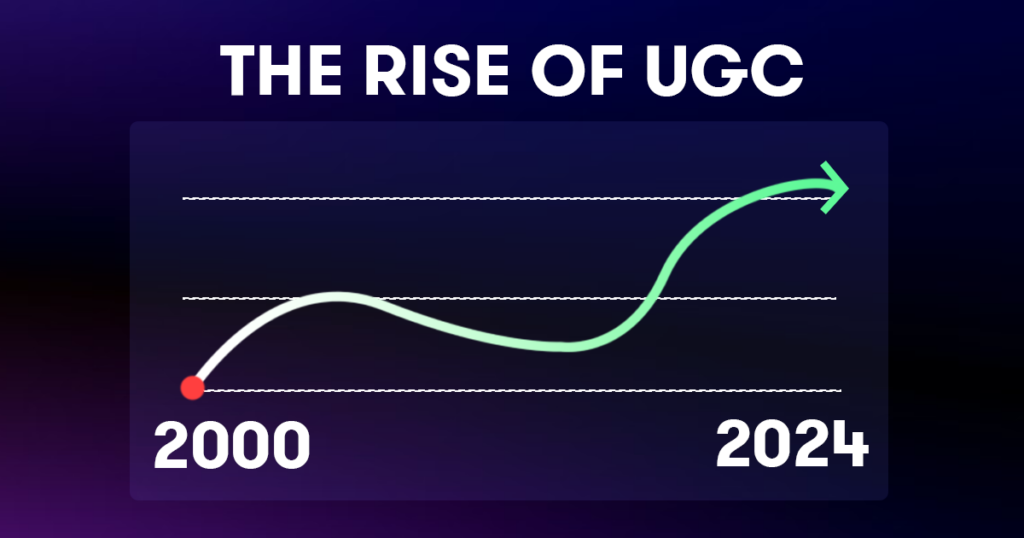
The rise of UGC is not a mere coincidence; it’s a reflection of how our online behaviors have evolved. With the proliferation of social media and the ease of content sharing, everyone’s a content creator now.
Whether it’s an Instagram post featuring a favorite meal or a YouTube review of a new gadget, UGC (and UGC ads) has become a powerful force in shaping the way we perceive brands and products.
Think about it: when was the last time you made a purchase decision without checking reviews or asking for recommendations from friends and family? If you’re like most of us, UGC has influenced your choices more than you realize.
We’re living in an age of social proof, where the experiences and opinions of our peers hold immense sway over our decisions. Marketers have recognized this shift and are tapping into the potential of UGC like never before.
The Subsequent Rise of UGC Platforms
With the increasing interest in the UGC, there has also been an increasing interest in the UGC platforms. Most often, they are used as marketplaces where brands and creators can meet to produce UGC content for video ads.
The best UGC platforms offer to connect creators and brands for easy collaboration. Offering easier matching, extensive filtering, and even real performance data that allows both sides to seek maximum results.
Benefits of UGC Platforms
The digital marketing world is a bustling marketplace where competition is fierce, and consumers are discerning. In this landscape, UGC platforms emerge as powerful allies for businesses. But what exactly are the benefits of leveraging these platforms?
1. Speed
One of the key benefits of using a UGC platform is the ability to speed up your marketing processes. They allow you to find and connect with brands and creators instantly. Instead of having to manually go and look for each creator, you can filter the databases and find the perfect match in minutes.
2. Credibility
Most UGC platforms do vet their creators. This means, you can trust that the end result will be delivered and can save time on doing additional background checks.
3. Performance insights
Another important thing to note, is that by creating the ad content via a UGC platform, you will be able to easily compare and analyze the performance of each ad. Such platforms eliminate the need to create your own reporting or being stuck comparing stats on different platforms.
4. Editing help
Lastly, most UGC platforms offer in-house editing services. You can use those to adjust the video from the creator and ensure the end product meets all of your requirements.
Curious to try out the best UGC platforms? Here is the one we recommend.
Best UGC Platforms
1. Billo
Billo – the best UGC platform for performance-driven video content. Sign up to review thousands of vetted creators, submit your project brief, and get results that perform.
2. Insense
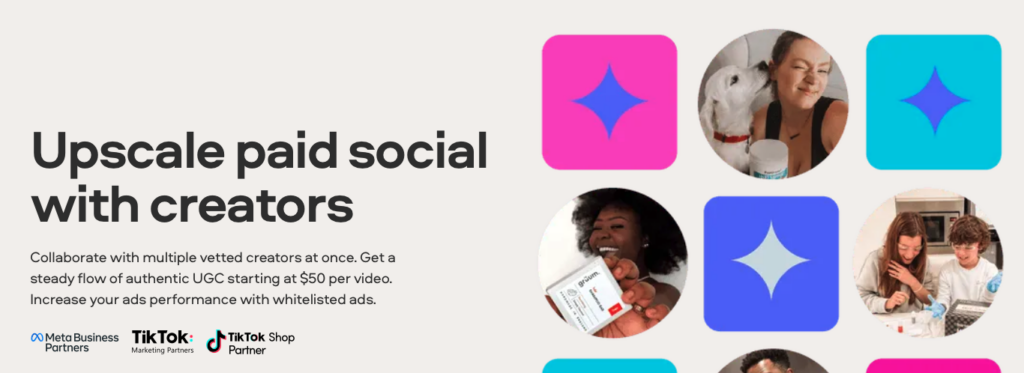
Insense is your choice for larger scale UGC ad campaigns that offer fewer analytical points. Here is a detailed analysis of Billo vs Insense.
3. Join Brands
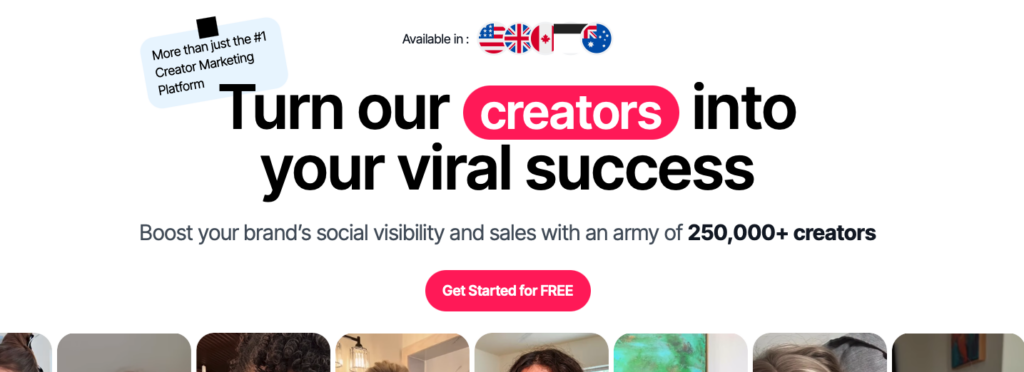
JoinBrands is a UGC platform focused on product new product launches. It is more curated towards brands that want to be quite involved in the creative process.
JoinBrands comparison to other UGC platforms
4. Trend
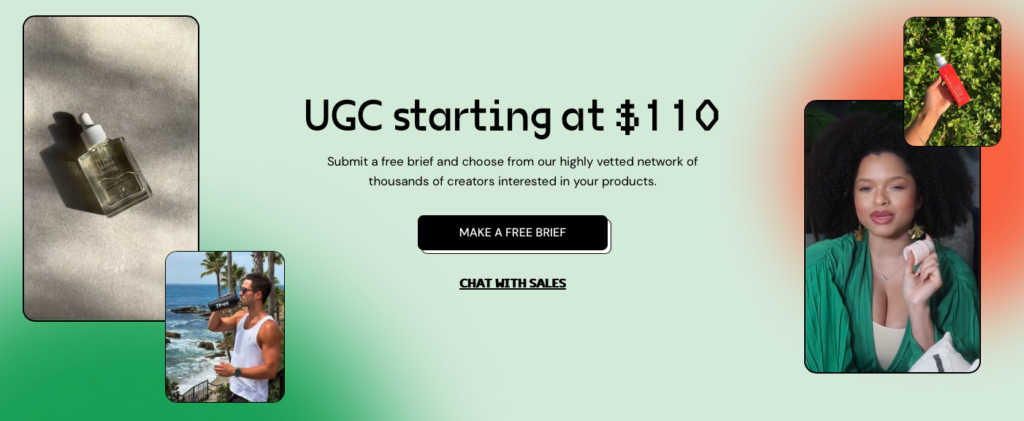
Trend is the go-to UGC platform for brands that want UGC product shots. You will have various UGC photography options to choose from for your next campaign.
Compare Trendio to other UGC platforms
5. Flowbox

Lastly, Flowbox will be a good fit for large online stores as they offer stock ad options and AI features.
Compare Flowbox to other UGC apps
Choosing the Right UGC Outlet
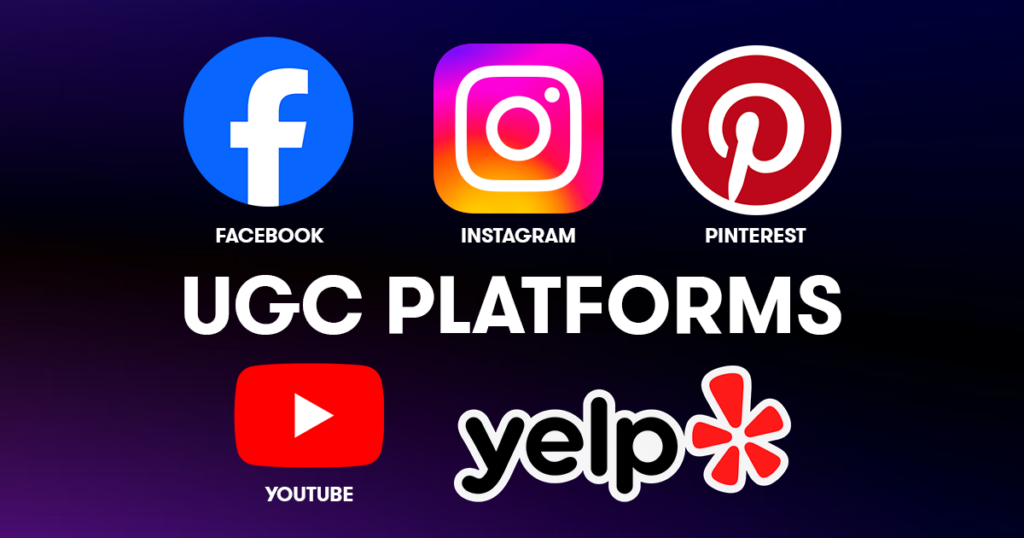
You’ve recognized the potential of user-generated content (UGC) platforms and are eager to get started, but with a multitude of options available, how do you go about selecting the outlet that’s the perfect fit for your brand? In this chapter, we’ll embark on the journey of choosing the right UGC platform.
Overview of Popular UGC Outlets
First things first, let’s take a look at some of the best UGC outlets that have made a significant impact in the digital marketing arena. These sites have diverse features and strengths, so getting to know them is a crucial first step.
1. Instagram
This photo and video-sharing platform is a hotspot for visual UGC. With features like Stories and Reels, it’s a favorite for brands that want to showcase user-generated content creatively.
2. Facebook
The world’s largest social network offers a plethora of tools for brands to harness UGC, from reviews and recommendations to groups and pages.
3. YouTube
If video UGC is your forte, YouTube is a powerhouse. Influencers, vloggers, and everyday users create content that can be seamlessly integrated into your marketing strategy.
4. Yelp
If you’re in the restaurant, hospitality, or service industry, Yelp is the go-to platform for user-generated reviews and recommendations.
5. Pinterest
Ideal for brands with visually appealing products or services, Pinterest encourages users to create boards and pins that can help amplify your brand’s reach.
Factors to Consider When Selecting a UGC Outlet
Selecting the right UGC outlet requires a strategic approach. Here are some critical factors to consider:
Audience: Where is your target audience most active? Knowing this will help you concentrate your efforts on the platforms where they are most likely to engage with your content.
Content Type: Different sites cater to various content types. Are you looking for image-centric content, super effective video ads, or written reviews? Your choice should align with the type of UGC you want to encourage.
Ease of Use: Consider how user-friendly the channel is. A complex structure might deter users from participating, while an intuitive one can drive engagement.
Moderation Tools: Ensure the site provides effective moderation tools to manage user-generated content. You’ll want to filter out inappropriate or irrelevant content.
Navigating Pricing and Features
Different social media channels come with distinct pricing models and features. While some platforms offer free access to basic features, they may charge for advanced options. It’s essential to carefully evaluate the pricing structure and the features you require.
Free vs. Paid: Some social media is free to use, while others offer paid partnerships or premium plans with additional features. Your budget and specific needs will dictate your choice.
Features: Assess the features offered. Do they align with your goals? Consider analytics, moderation tools, and integration capabilities when making your decision.
Tips for Finding the Perfect Fit for Your Brand
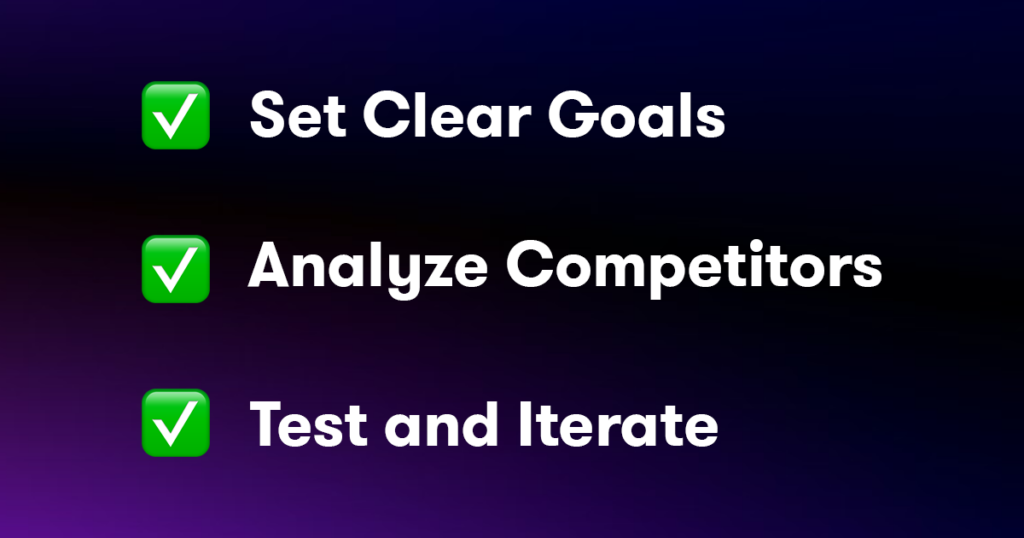
Below you’ll find a few tips for determining which UGC platforms best fit your brand or business:
Set Clear Goals: Begin by defining your UGC objectives. Are you looking to increase brand awareness, drive sales, or foster community engagement? Your goals will guide your platform selection.
Analyze Competitors: Study your competitors’ UGC strategies. Which UGC channels are they using, and how successful are they? Learning from their experiences can provide valuable insights.
Test and Iterate: Don’t be afraid to experiment with multiple UGC platforms and approaches. Analyze the results and adjust your strategy as needed. It’s an ongoing process.
In this world of abundant UGC platforms, finding the perfect fit for your brand is a matter of understanding your audience, the type of content you want, platform features, and your budget. By approaching this decision strategically, you can set your brand on the path to UGC success.
Implementing UGC Platforms Effectively
You’ve chosen the perfect user-generated content (UGC) platform for your brand, and now it’s time to put your strategy into action. This chapter will guide you through the process of implementing UGC platforms effectively, from setup to optimization.
Setting up your UGC platform
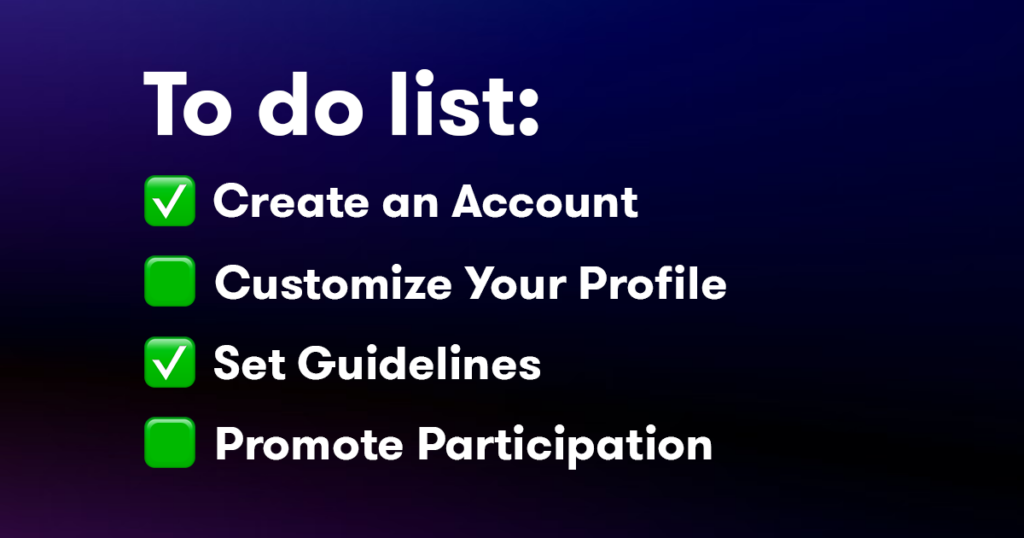
Before you can start reaping the benefits of UGC, you need to set up your chosen platform. Here’s a step-by-step guide to getting started:
- Create an Account: Sign up on the UGC platform of your choice and set up a business account if available.
- Customize Your Profile: Personalize your profile with your brand’s logo, images, and a compelling bio.
- Set Guidelines: Establish clear and concise guidelines for user-generated content. Communicate what is acceptable and what isn’t. This will help users understand your expectations and avoid any content that might be against your brand’s values.
- Promote Participation: Kickstart engagement by encouraging your existing customers to contribute. Host contests or giveaways to motivate users to create content related to your brand.
Best Practices for Encouraging User-Generated Content
Creating a thriving community of contributors is crucial for the success of your UGC strategy. Here are some best practices to encourage user-generated content:
Showcase Examples: Share examples of user-generated content to inspire others. This serves as social proof that your brand appreciates and features UGC.
Use Hashtags: Create a unique and branded hashtag for your campaigns. It makes it easier for users to find and contribute to your UGC initiatives.
Acknowledge and Reward: Recognize and reward users who contribute valuable UGC. Acknowledging their efforts builds loyalty and encourages ongoing participation.
Tell a Story: Encourage users to share their stories related to your brand. Storytelling creates a deeper emotional connection between your brand and your customers.
Strategies for Moderating and Curating Content
UGC can be a double-edged sword. While it can bring in a treasure trove of great content, it can also lead to some content that doesn’t align with your brand values. Here’s how to manage and curate content effectively:
Use Moderation Tools: Utilize the moderation tools provided by the platform to filter out inappropriate or off-topic content. This ensures that only the best content gets featured.
Go For Consistency: Be consistent in your content curation. Maintain a clear editorial strategy to ensure the content you showcase aligns with your brand’s image and messaging.
Choose Transparency: Be transparent with your audience about your curation process. Let them know why certain content is featured while others may not be. Transparency builds trust.
Measuring Success and Optimizing Your Approach
To ensure that your UGC strategy is effective, you must measure its impact and make data-driven optimizations. Here’s how to go about it:
- Define specific KPIs to measure success, such as engagement metrics (likes, shares, comments), conversion rates, and the volume of user-generated content.
- Utilize analytics tools provided by the platform, or third-party tools if needed, to track the performance of your UGC campaigns.
- Periodically audit your UGC campaigns to evaluate what’s working and what’s not. This will help you make informed adjustments and improvements.
- Experiment with different UGC strategies to see which ones yield the best results. A/B testing can provide valuable insights for optimization.
- Remember that UGC is not a one-and-done strategy; it’s an ongoing process that requires dedication and a willingness to adapt.
- By effectively setting up your platform, encouraging participation, moderating content, and constantly measuring and optimizing, you can harness the true power of UGC to elevate your brand’s digital presence and reputation.
UGC Platform Legal and Ethical Considerations
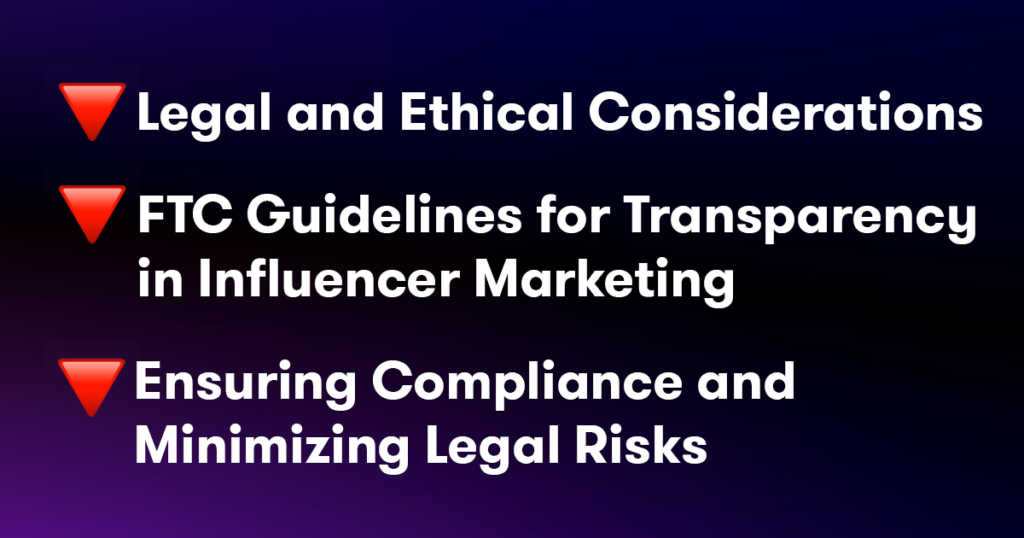
As you venture deeper into the world of UGC platforms, it’s essential to navigate the legal and ethical landscape that surrounds them. Failure to do so can result in significant legal and reputational risks. Most UGC platforms will ensure you have full rights to the content, but when sourcing UGC from the web, there are certain things to be wary of.
In this chapter, we’ll explore the key considerations to ensure your UGC strategy is on the right side of the law and ethics.
Copyright and Intellectual Property Issues
User-generated content is a treasure trove of creativity, but it’s also a potential minefield of copyright and intellectual property concerns. Here’s how to address these issues:
- When users share content, they often retain the copyright to it. Before repurposing UGC, seek permission from the content creators or ensure that the platform’s terms of service grant you the rights to use the content.
- Always credit the content creator when using their work. This not only respects their intellectual property rights but also builds goodwill within the UGC community.
- Familiarize yourself with the concept of “fair use” in copyright law. In some cases, using copyrighted material may be legally allowed for purposes such as commentary, criticism, or news reporting.
Privacy Concerns and Data Protection
Respecting the privacy of your users is paramount. UGC often involves sharing personal experiences and data. Here’s how to address privacy concerns:
- Be aware of data protection laws in your jurisdiction, such as the General Data Protection Regulation (GDPR) in Europe or the California Consumer Privacy Act (CCPA) in the U.S. Ensure your UGC activities comply with these regulations.
- When collecting user-generated content, obtain clear and informed consent from users for the collection and use of their data. This includes permission for sharing their content and data on your platform.
- Allow users to remain anonymous or use pseudonyms if they wish. Respecting their privacy preferences is essential.
FTC Guidelines for Transparency in Influencer Marketing
If your UGC strategy involves influencer marketing, it’s vital to comply with the Federal Trade Commission (FTC) guidelines to maintain transparency. Here’s what you need to know:
- Disclosure: Influencers must clearly disclose their relationship with your brand when endorsing or promoting your products. Ensure they use appropriate hashtags like #Ad or #Sponsored.
- Truthful Representation: Influencers must provide truthful representations of your products or services. Misleading claims can result in legal trouble.
- Monitoring and Enforcement: Implement processes to monitor and enforce compliance with these guidelines. You share responsibility for ensuring that influencers follow the rules.
Ensuring Compliance and Minimizing Legal Risks
To ensure compliance and minimize legal risks in your UGC campaigns, consider the following best practices:
- Consult with legal experts or specialists in digital marketing law to ensure your UGC activities are legally sound.
- Implement strong content moderation to prevent the spread of illegal or inappropriate content.
- Clearly communicate your user guidelines and terms of service to set expectations and boundaries for contributors.
- Periodically audit your UGC campaigns to ensure they align with the law and ethical standards. Make necessary adjustments when required.
By understanding and addressing these legal and ethical considerations, you can safeguard your brand’s reputation and minimize the legal risks associated with UGC platforms. Stick to all four of the above recommendations and you should be just fine.
Remember that a transparent, ethical, and legally compliant approach not only protects your business but also fosters trust with your audience and UGC contributors.
The Future of UGC Platforms
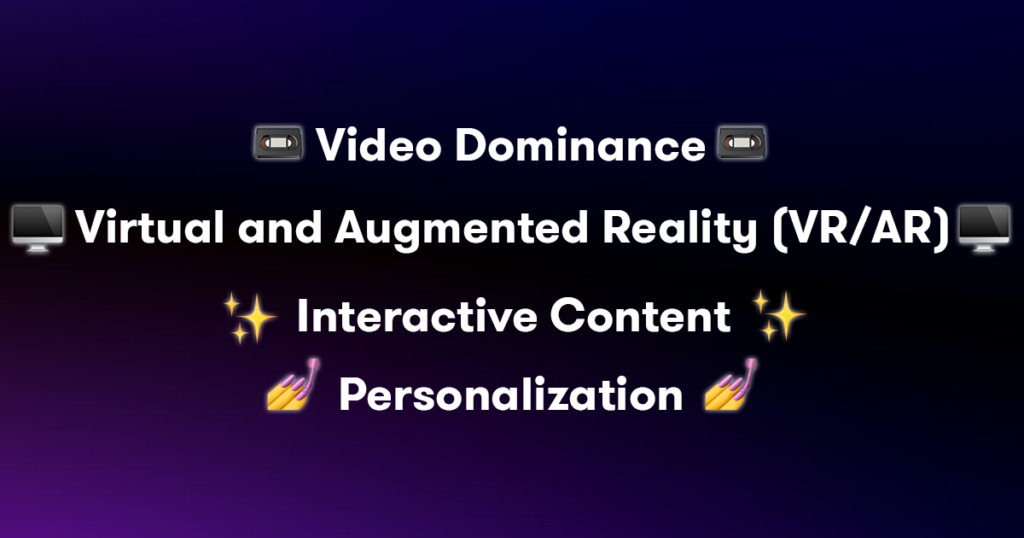
The world of digital marketing is in a constant state of evolution, and User-Generated Content (UGC) platforms are no exception. In this chapter, we’ll peer into the crystal ball and explore the exciting future of UGC platforms, including emerging trends, the role of artificial intelligence (AI), and our predictions for their evolution in the coming years.
Emerging Trends and Innovations in UGC
The future of UGC is teeming with innovations that promise to reshape the way brands interact with their audience and harness the power of user-generated content. Here are some of the emerging trends:
Video Dominance
Video content is on the rise, and it’s expected to become even more prevalent in UGC. Short-form videos, live streaming, and interactive video experiences will become standard.
Virtual and Augmented Reality (VR/AR)
The integration of VR and AR into UGC platforms will enable users to create immersive experiences, from virtual try-ons for fashion brands to interactive product demos.
Interactive Content
Gamification and interactive content will continue to engage users and foster brand loyalty. Contests, quizzes, and polls will be used to encourage participation.
Personalization
UGC platforms will leverage AI to personalize content recommendations for users. This ensures that the content they see is relevant to their interests and preferences.
The Role of AI and Technology in Shaping UGC

Artificial intelligence is poised to play a pivotal role in the evolution of UGC platforms. AI brings a range of capabilities that enhance content creation, moderation, and user experience:
Content Generation: AI-powered tools can assist users in generating content, from automatically transcribing spoken words to converting text into video presentations.
Content Moderation: AI algorithms can help in real-time content moderation, identifying and flagging inappropriate or harmful content.
Data Analysis: AI-driven data analysis will provide brands with deeper insights into consumer behaviors and sentiment analysis, allowing for more targeted UGC strategies.
Personalization: AI will help in understanding individual user preferences and delivering tailored UGC content, increasing engagement and conversion rates.
Predictions for the Evolution of UGC Platforms in the Coming Years
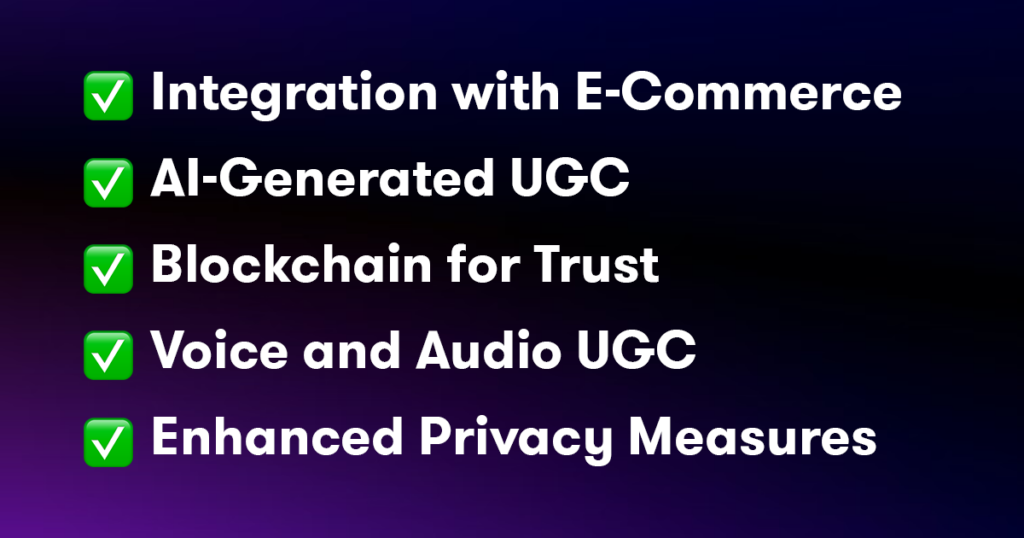
As UGC platforms continue to evolve, here are some predictions for their future:
- Integration with E-Commerce: UGC platforms will become seamless e-commerce channels. Users can discover, evaluate, and purchase products without leaving the UGC platform.
- AI-Generated UGC: AI will not only assist in content creation but may also autonomously generate UGC in the form of reviews, testimonials, and even stories based on user data.
- Blockchain for Trust: Blockchain technology will be used to verify the authenticity of user-generated content and ensure transparency in influencer marketing.
- Voice and Audio UGC: With the rise of voice-activated devices and audio content, platforms will adapt to accommodate voice UGC, like podcasts and voice reviews.
- Enhanced Privacy Measures: UGC platforms will focus on enhancing privacy controls to address user concerns about data security and consent.
In the near future, UGC platforms are set to revolutionize how brands connect with their audiences. By embracing emerging trends, harnessing the power of AI, and staying ahead of the curve, brands can ensure that they remain at the forefront of this dynamic and ever-evolving field.
UGC is no longer just a marketing strategy; it’s a cornerstone of brand engagement and customer trust. The future promises even greater possibilities.
Choose the Right UGC Platform
Choosing the right UGC platform for your brand is akin to finding the perfect partner in a crowded digital dance. The multitude of options, each with its unique features and strengths, can be overwhelming. However, the key is not just selecting a platform but learning it intimately and committing to a long-term relationship.
Start by gaining a deep understanding of the popular UGC platforms mentioned, such as Instagram, Facebook, YouTube, Yelp, and Pinterest. Explore their nuances, audience demographics, and the types of content they excel in hosting. Consider where your target audience is most active and align your efforts accordingly. It’s not just about being where everyone else is; it’s about being where your audience is most engaged.
Once you’ve chosen a platform, dive into its intricacies. Customize your profile with your brand’s identity, ensuring it reflects the essence of your business. Set clear and concise guidelines for user-generated content, communicating expectations and values to contributors. Promote active participation by initiating contests or giveaways, kickstarting a cycle of engagement that benefits both your brand and your audience.
Stick With It!
Learning the ins and outs of your chosen platform is an ongoing process. Stay updated on new features, algorithm changes, and emerging trends within the platform’s community. Familiarize yourself with moderation tools to maintain the quality and relevance of user-generated content. A well-moderated platform not only ensures a positive user experience but also protects your brand from potential pitfalls.
Sticking to a chosen UGC platform doesn’t mean being stagnant. It means building a consistent presence and fostering a loyal community. Showcase examples of outstanding user-generated content to inspire others, and create a unique and branded hashtag to make your campaigns easily discoverable. Acknowledge and reward contributors, turning them into cherished brand advocates.
In digital marketing, trends may come and go, but building a strong relationship with a UGC platform is a commitment that pays off. By investing time and effort in understanding your chosen platform, you can leverage its full potential to amplify your brand’s reach and impact.
Remember, success in UGC is not just about making a choice; it’s about making a commitment to nurture and grow your brand within the digital community you’ve chosen to be a part of.
Additional UGC Platform Resources
As you dive deeper into the world of User-Generated Content (UGC) strategies, it’s important to have the right tools and knowledge at your disposal.
Here, we’ve compiled a list of resources and recommendations to help you implement and optimize your UGC initiatives.
Links to Tools and Resources for Implementing UGC Strategies
UGC Platform Selection:
Content Moderation:
Legal and Compliance:
UGC Analytics:
Recommended Further Reading and Case Studies
Books on UGC:
- “The Power of Visual Storytelling” by Ekaterina Walter and Jessica Gioglio
- “Contagious: How to Build Word of Mouth in the Digital Age” by Jonah Berger
Industry Publications:
Case Studies and Whitepapers:
Online Communities and Forums:
By exploring these resources, you’ll gain a deeper understanding of UGC strategies, best practices, and the tools that can support your efforts.

Authentic creator videos, powered by real performance data
22,000+ brands use Billo to turn UGC into high-ROAS video ads.
From Avatars to Authenticity: Navigating the 2025 Wave of AI Generated UGC
That UGC ad you just watched? The person might not [...]...
Read full articleMastering UGC Scripts: Best Practices, Templates & Creator Insight
In 2025, brands are facing the most competitive short-form video [...]...
Read full articleFrom Hashtags to Sales: UGC Campaign Examples That Worked
User-generated content (UGC) campaigns are reshaping how brands build trust and [...]...
Read full article



